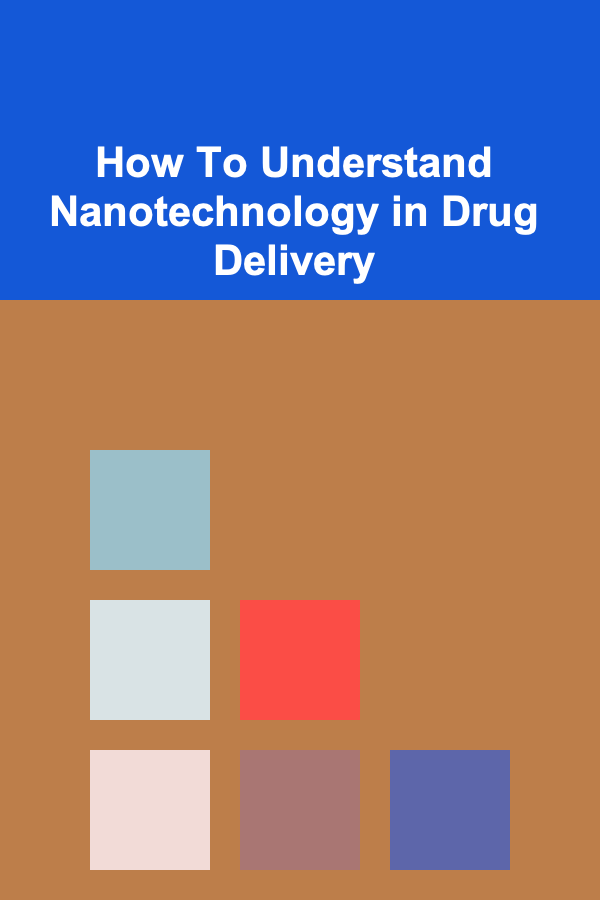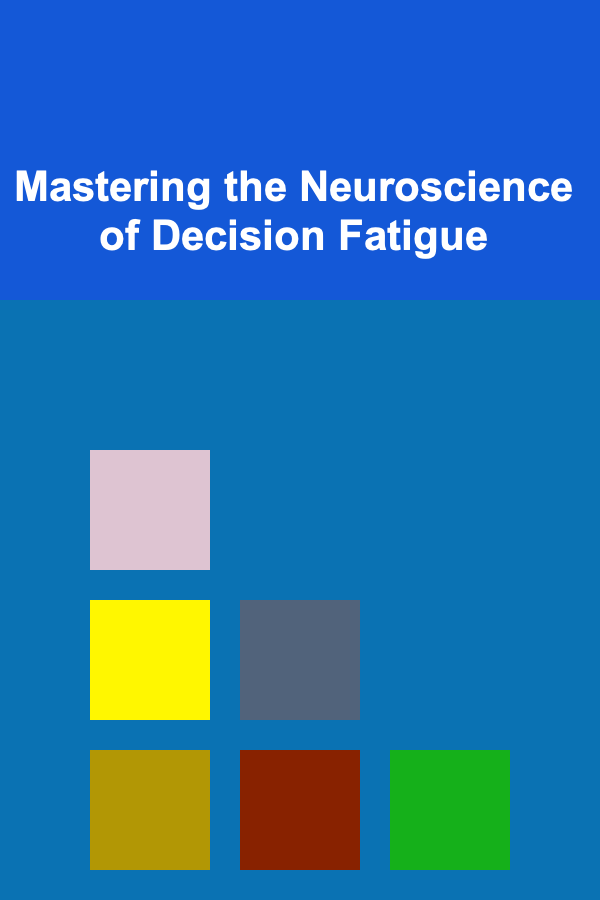
How To Understand Nanotechnology in Drug Delivery
ebook include PDF & Audio bundle (Micro Guide)
$12.99$8.99
Limited Time Offer! Order within the next:

Nanotechnology has revolutionized numerous fields, and one of its most promising applications is in the realm of medicine, particularly in drug delivery systems. The ability to manipulate materials at the nanometer scale---approximately one-billionth of a meter---enables researchers to design drugs and delivery systems that are vastly more efficient and targeted than traditional therapies. This article provides a comprehensive understanding of nanotechnology in drug delivery, focusing on its principles, mechanisms, challenges, and future prospects.
What is Nanotechnology in Drug Delivery?
Nanotechnology in drug delivery refers to the design, development, and application of nanomaterials to deliver drugs to specific locations within the body in a controlled manner. At the nanoscale, materials exhibit unique physical, chemical, and biological properties compared to their bulk counterparts. This makes them ideal candidates for improving the pharmacokinetics, bioavailability, and targeting of drugs.
In drug delivery, the goal is to ensure that drugs reach the right place in the right concentration and are released over an optimal time period. Nanotechnology helps to achieve these objectives by enabling controlled release, targeting specific tissues or cells, and overcoming biological barriers that typically hinder drug effectiveness.
Key Principles of Nanotechnology in Drug Delivery
1. Nanocarriers
Nanocarriers are materials designed to carry drugs and protect them during their journey to the target site. They can be made of various materials, including lipids, polymers, or inorganic substances. Common types of nanocarriers include:
- Liposomes: Small, spherical vesicles made of lipid bilayers that can encapsulate both hydrophilic and hydrophobic drugs. They can be functionalized to enhance targeting.
- Polymeric Nanoparticles: Made from biodegradable polymers, these nanoparticles can carry drugs and release them in a controlled manner over time.
- Dendrimers: Highly branched, tree-like structures that offer precise control over drug release and targeting.
- Nanoshells: Core-shell structures with properties that allow for controlled release and easy modification for targeting specific cells.
2. Drug Release Mechanisms
The mechanism by which a drug is released from a nanocarrier is crucial for ensuring that the drug remains effective and reaches its target. Common release mechanisms include:
- Diffusion-Controlled Release: The drug diffuses out of the carrier over time, and the release rate is typically controlled by the permeability of the carrier.
- pH-Sensitive Release: The drug is released in response to changes in pH, which is especially useful for targeting areas with specific pH conditions, such as tumors or the gastrointestinal tract.
- Temperature-Sensitive Release: Some nanocarriers are designed to release drugs when exposed to specific temperatures, making them useful for localized treatment, like during hyperthermia therapy.
- Enzyme-Mediated Release: Nanocarriers can be engineered to release their payloads in response to specific enzymes present in the target area, such as those secreted by tumor cells.
3. Targeted Drug Delivery
Targeted drug delivery is one of the key advantages of nanotechnology in medicine. By attaching ligands (molecules that can bind to specific receptors) to the surface of nanocarriers, drugs can be directed to a particular site in the body, such as a tumor, infected tissue, or diseased organ. The targeting strategies can be broadly classified into:
- Passive Targeting: This relies on the unique characteristics of the disease site, such as the enhanced permeability and retention (EPR) effect in tumors, which allows nanoparticles to accumulate more readily in cancerous tissue due to its leaky blood vessels.
- Active Targeting: This involves attaching specific targeting ligands to the surface of nanoparticles that can recognize and bind to receptors overexpressed on the target cells, such as those on cancer cells.
- Magnetic Targeting: Magnetic nanoparticles can be directed to specific locations using an external magnetic field, making them useful for targeting areas in the brain or liver.
Advantages of Nanotechnology in Drug Delivery
1. Enhanced Bioavailability
Nanotechnology enables drugs to be delivered in a way that maximizes their bioavailability, the proportion of the drug that enters the bloodstream and reaches the target tissue. This is particularly important for drugs that are poorly soluble or have low absorption rates. By encapsulating drugs in nanoparticles, they can be delivered more effectively, reducing the need for high doses.
2. Improved Solubility and Stability
Many drugs, especially those that are hydrophobic (water-insoluble), face challenges in terms of solubility and stability in the body. Nanoparticles can be engineered to enhance the solubility of these drugs, allowing them to be more easily absorbed and transported through the bloodstream. Additionally, nanoparticles can protect the drug from degradation in the body, ensuring that it remains stable until it reaches the target site.
3. Reduced Side Effects
By targeting drugs directly to specific cells or tissues, nanotechnology minimizes the exposure of healthy tissues to the drug, thereby reducing the potential for side effects. This is particularly beneficial in the treatment of diseases like cancer, where chemotherapy drugs can cause severe side effects due to their effect on healthy cells.
4. Controlled and Sustained Release
Nanocarriers can be designed to release their payloads gradually over time, offering controlled and sustained release. This can help to maintain therapeutic drug concentrations for longer periods, reducing the need for frequent dosing and improving patient compliance.
5. Crossing Biological Barriers
Nanoparticles have unique properties that allow them to cross biological barriers that would typically prevent conventional drug delivery. For instance, nanoparticles can cross the blood-brain barrier (BBB), allowing for the delivery of drugs to the brain, a feat that is often challenging for traditional drug delivery systems.
Challenges in Nanotechnology-Based Drug Delivery
Despite the promising potential of nanotechnology, several challenges must be addressed before it can be widely adopted in clinical settings.
1. Toxicity Concerns
One of the primary concerns with the use of nanotechnology in drug delivery is the potential toxicity of nanomaterials. Some nanoparticles can accumulate in the body over time and cause adverse effects. The size, shape, surface charge, and material composition of nanoparticles all influence their toxicity. Careful testing is required to ensure that nanomaterials are biocompatible and safe for use in humans.
2. Scalability and Manufacturing
While laboratory research has shown the potential of nanotechnology in drug delivery, scaling up these processes for mass production remains a significant challenge. Producing nanoparticles in large quantities with consistent quality is complex and costly, which can hinder their widespread clinical use.
3. Regulatory Hurdles
The approval process for nanotechnology-based drug delivery systems is still evolving. Regulatory bodies like the U.S. Food and Drug Administration (FDA) and the European Medicines Agency (EMA) are developing guidelines for the safety and efficacy of nanomedicines. However, the lack of standardized protocols for testing nanomaterials means that the approval process can be lengthy and uncertain.
4. Long-Term Stability
For nanotechnology-based drug delivery systems to be effective, they need to remain stable over time. Factors such as storage conditions, pH, and temperature can affect the stability of nanoparticles and their ability to release drugs in a controlled manner. Ensuring that these systems maintain their efficacy in real-world conditions is crucial for their success.
5. Immune Response
The immune system can recognize foreign nanoparticles as potential threats and mount an immune response. This can lead to the premature clearance of nanoparticles from the body or even cause allergic reactions. Strategies to overcome immune system recognition, such as "stealth" nanoparticles that avoid immune detection, are actively being developed.
Future Prospects of Nanotechnology in Drug Delivery
Despite these challenges, the future of nanotechnology in drug delivery is promising. Research in this field is rapidly advancing, and new innovations are constantly emerging. Some of the most exciting prospects include:
1. Personalized Medicine
Nanotechnology has the potential to play a key role in personalized medicine, where treatments are tailored to the individual's genetic makeup, disease profile, and response to therapy. Nanocarriers can be designed to target specific genetic markers or biomarkers, allowing for more precise treatment options.
2. Gene Therapy
Nanotechnology could facilitate the delivery of gene therapies, where genetic material is introduced into cells to correct faulty genes or treat diseases. Nanoparticles could be used to deliver DNA, RNA, or CRISPR components directly to the target cells, enabling the repair of genetic defects at the molecular level.
3. Immunotherapy
In the field of cancer treatment, nanotechnology-based drug delivery systems can be used to enhance immunotherapy, which harnesses the body's immune system to fight cancer. By delivering immune-boosting agents directly to tumors, nanotechnology could increase the effectiveness of these therapies and reduce side effects.
4. Smart Nanomedicines
Smart nanomedicines are nanocarriers that respond to environmental stimuli, such as changes in temperature, pH, or the presence of specific molecules. These systems could offer highly targeted drug delivery, releasing their payloads only when they reach the desired site, thereby improving efficacy and minimizing side effects.
Conclusion
Nanotechnology in drug delivery represents a paradigm shift in how we approach the treatment of diseases. Its ability to improve drug bioavailability, provide controlled release, and target specific tissues opens up new possibilities for more effective therapies with fewer side effects. While challenges remain in terms of toxicity, manufacturing, and regulatory approval, ongoing research promises to overcome these obstacles and make nanotechnology-based drug delivery a mainstream clinical tool in the future.
As we move forward, nanotechnology's role in medicine will continue to evolve, offering more sophisticated and personalized treatment options for patients worldwide. The potential for improving the quality of life through these innovative systems is immense, and the continued development of nanomedicines promises to change the landscape of healthcare forever.

How to Create a Smart School Supply Station for Kids
Read More
How to Offer Remote IT Support Services to Home Users
Read More
How to Understand Blockchain Bridges
Read More
How to Secure Your Online Meeting Platforms
Read More
How to Detox Your Body Naturally Through Food
Read More
Mastering the Neuroscience of Decision Fatigue
Read MoreOther Products

How to Create a Smart School Supply Station for Kids
Read More
How to Offer Remote IT Support Services to Home Users
Read More
How to Understand Blockchain Bridges
Read More
How to Secure Your Online Meeting Platforms
Read More
How to Detox Your Body Naturally Through Food
Read More